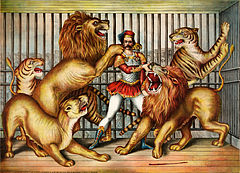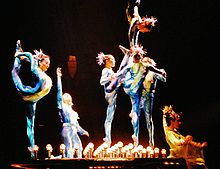- Circus
-
This article is about the event. For other uses, see Circus (disambiguation)."3 ring circus" redirects here. For the Martin and Lewis film, see 3 Ring Circus.
Circus 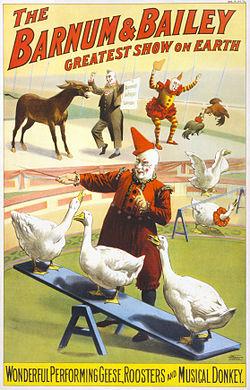
Advertisement for the Barnum & Bailey Circus, 1900.Types Contemporary circus Ancestor arts Drama Originating culture Ancient Rome Performing arts Major formsMinor formsGenresDrama · Tragedy · Comedy · Tragicomedy · Romance · Satire · Epic · Lyric
A circus is commonly a travelling company of performers that may include clowns, acrobats, trained animals, trapeze acts, musicians, hoopers, tightrope walkers, jugglers, unicyclists and other stunt-oriented artists. The word also describes the performance that they give, which is usually a series of acts that are told how to play music and introduced by a "ringmaster".A traditional circus performance is normally held in a ring 13m (42ft) in diameter. This dimension was adopted by Philip Astley to enable a horse rider to stand upright on a cantering horse to perform a series of acrobatic manoeuvres and to more easily retain their balance. Most modern circuses have a system of tiered seating around the ring for the public and since the late 19th early 20th century the performance has taken place under canvas and more recently plastic tents commonly called "The Big Top" .
Contents
Etymology
First attested in English 14th century, the word circus derives from Latin "circus",[1] which is the romanization of the Greek "κίρκος" (kirkos), itself a metathesis of the Homeric Greek "κρίκος" (krikos), meaning "circle" or "ring".[2]
History
Origin
In Ancient Rome, the circus was a building for the exhibition of horse and chariot races, equestrian shows, staged battles, displays featuring trained animals, jugglers and acrobats. The circus of Rome is thought to have been influenced by the Greeks, with chariot racing and the exhibition of animals as traditional attractions. The Roman circus consisted of tiers of seats running parallel with the sides of the course, and forming a crescent around one of the ends. The lower seats were reserved for persons of rank; there were also various state boxes, e.g. for the giver of the games and his friends. In Ancient Rome the circus was the only public spectacle at which men and women were not separated.
The first circus in Rome was the Circus Maximus, in the valley between the Palatine and Aventine hills. It was constructed during the monarchy and, at first, built completely from wood. After being rebuilt several times, the final version of the Circus Maximus could seat 250,000 people; it was built of stone and measured 400 m in length and 90 m in width.[3] Next in importance to the Circus Maximus in Rome were the Circus Flaminius and the Circus Neronis, from the notoriety which it obtained through the Circensian pleasures of Nero. A fourth, the Circus of Maxentius, was constructed by Maxentius; the ruins of this circus have helped archaeologists to reconstruct the Roman circus.
For some time after the fall of Rome, Europe lacked a large and animal-rich circus. Itinerant showmen travelled the fairgrounds of Europe. Animal trainers and performers are thought to have exploited the nostalgia for the Roman circus, travelling between towns and performing at local fairs. Another possible link between the Roman and modern circus could have been bands of Gypsies who appeared in Europe in the 14th century and in Britain from the 15th century, bringing with them circus skills and trained animals.[citation needed]
Development
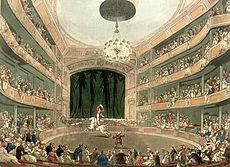 Astley's Amphitheatre in London c.1808
Astley's Amphitheatre in London c.1808
The modern concept of a circus as a circular arena surrounded by tiers of seats, for the exhibition of equestrian, acrobatic and other performances seems to have existed since the late 18th century.[4] The popularity of the circus in England may be traced to that held by Philip Astley in London.[5] The first performance of his circus is said to have been held on January 9, 1768. One of Astley's major contributions to the circus was bringing trick horse-riding into a ring, though Astley referred to it as the Circle. Later, to suit equestrian acts moving from one circus to another, the diameter of the circus ring was set at 42 feet (13 m), which is the size of ring needed for horses to circle comfortably at full gallop. Astley never called his performances a 'circus'; that title was thought up by his rival Charles Hughes, who set up his Royal Circus a short distance from Astley's 'Amphitheatre of Equestrian Arts' in Lambeth, London. When Astley added tumblers, tightrope-walkers, jugglers, performing dogs, and a clown to fill time between his own demonstrations, he created a modern circus.[6][7]
Astley was followed by Andrew Ducrow, whose feats of horsemanship had much to do with establishing the traditions of the circus, which were perpetuated by Henglers and Sangers celebrated shows in a later generation. In England circuses were often held in purpose built buildings in large cities, such as the London Hippodrome, which was built as a combination of the circus, the menagerie and the variety theatre, where wild animals such as lions and elephants from time to time appeared in the ring, and where convulsions of nature such as floods, earthquakes and volcanic eruptions have been produced with an extraordinary wealth of realistic display. Antonio Franconi, the founder of the French circus, is credited by many to be a co-creator of the modern circus, along with Philip Astley.
 Trapeze artists, in lithograph by Calvert Litho. Co., 1890.
Trapeze artists, in lithograph by Calvert Litho. Co., 1890.
The Englishman John Bill Ricketts brought the first modern circus to the United States. He began his theatrical career with Hughes Royal Circus in London in the 1780s, and came over from England in 1792 to establish his first circus in Philadelphia. The first circus building in the U.S opened on April 3, 1793 in Philadelphia, where Ricketts gave America's first complete circus performance.[6][8] George Washington attended a performance there later that season.[9]
In the Americas of the first two decades of the 19th century, the Circus of Pepin and Breschard toured from Montreal to Havana, building circus theatres in many of the cities it visited. Victor Pépin, a native New Yorker,[10] was the first American to operate a major circus in the United States.[11] Later the establishments of Purdy, Welch & Co., and of van Amburgh gave a wider popularity to the circus in the United States. In 1825 Joshuah Purdy Brown was the first circus owner to use a large canvas tent for the circus performance. Circus pioneer Dan Rice was probably the most famous circus and clown pre-Civil War, popularizing such expressions as "The One-Horse Show" and "Hey, Rube!". The American circus was revolutionized by P. T. Barnum and William Cameron Coup, who launched P. T. Barnum's Museum, Menagerie & Circus, a travelling combination of animal and human oddities, the exhibition of humans as a freak show or sideshow was thus an American invention. Coup was also the first circus entrepreneur to use circus trains to transport the circus from town to town; a practice that continues today and introduced the first multiple ringed circuses.
In 1840 the equestrian Thomas Cooke returned to England from the United States, bringing with him a circus tent. At this time, itinerant circuses were becoming popular in Britain. William Batty's circus, for example, between 1838 and 1840, travelled from Newcastle to Edinburgh and then to Portsmouth and Southhampton. Pablo Fanque, who is noteworthy as Britain's only black circus proprietor and who operated one of the most celebrated travelling circuses in Victorian England, erected temporary structures for his limited engagements or retrofitted existing structures. [12] One such structure in Leeds, which Fanque assumed from a departing circus, collapsed, resulting in minor injuries to many but the death of Fanque's wife. [13] [14] Three important circus innovators were Italian Giuseppe Chiarini, and Frenchmen Louis Soullier and Jacques Tourniaire, whose early travelling circuses introduced the circus to Latin America, Australia, South East Asia, China, South Africa and Russia. Soullier was the first circus owner to introduce Chinese acrobatics to the European circus when he returned from his travels in 1866 and Tourniaire was the first to introduce the performing art to Ranga where it became extremely popular. Following Barnum's death his circus merged with that of James Anthony Bailey, and travelled to Europe as The Barnum & Bailey Greatest Show On Earth where it toured from 1897 to 1902, impressing other circus owners with its large scale, its touring techniques including the tent and circus train and the combination of circus acts, zoological exhibition and the freak show. This format was adopted by European circuses at the turn of the 20th century.
The influence of the American circus brought about a considerable change in the character of the modern circus. In arenas too large for speech to be easily audible, the traditional comic dialog of the clown assumed a less prominent place than formerly, while the vastly increased wealth of stage properties relegated to the background the old-fashioned equestrian feats, which were replaced by more ambitious acrobatic performances, and by exhibitions of skill, strength and daring, requiring the employment of immense numbers of performers and often of complicated and expensive machinery.
In 1919, Lenin, head of the USSR, expressed a wish for the circus to become 'the people's art-form', given facilities and status on a par with theatre, opera and ballet. The USSR nationalized the Soviet circuses. In 1927 the State University of Circus and Variety Arts, better known as the Moscow Circus School was established where performers were trained using methods developed from the Soviet gymnastics program. When the Moscow State Circus company began international tours in the 1950s, its levels of originality and artistic skill were widely applauded, and the high standard of the Russian State circus continues to this day.
Circuses from China, drawing on Chinese traditions of acrobatics, like the Chinese State Circus are also popular touring acts. The International Circus Festival of Monte-Carlo[15] has been held in Monte Carlo since 1974 and was the first of many international awards for circus performers. In the 1960s and 1970s, the circus began to lose popularity as the general public became more interested in alternative forms of entertainment such as movies, music, and TV shows. Some circuses stayed afloat by merging with other circus companies. However a good number of old-fashioned travelling circuses with their usual mixture of acrobat, clown and animal acts are still active in various parts of the world ranging from small family enterprises on the edge of survival to the three ring extravaganzas like Vazquez Hermanos Circus in Mexico.[16] Other companies found new ways to draw in the public with innovative new approaches to the circus form itself.
Contemporary types
Main article: Contemporary circusContemporary circus (originally known as nouveau cirque) is a recent performing arts movement that originated in the 1970s in Australia, Canada, France, the West Coast of the United States, and the United Kingdom. Contemporary circus combines traditional circus skills and theatrical techniques to convey a story or theme. Compared with the traditional circus, the contemporary genre of circus tends to focus more attention on the overall aesthetic impact, on character and story development, and on the use of lighting design, original music, and costume design to convey thematic or narrative content. For aesthetic or economic reasons, contemporary circus productions may sometimes be staged in theatres rather than in large outdoor tents. Music used in the production is often composed exclusively for that production, and aesthetic influences are drawn as much from contemporary culture as from circus history. Animal acts appear less frequently in contemporary circus than in traditional circus.
Early examples of nouveau cirque companies include: Circus Oz, forged in Australia in 1978 from SoapBox Circus and New Circus, both founded in the early 1970s; the Pickle Family Circus, founded in San Francisco in 1975; Nofit State Circus in 1984 from Wales; Cirque du Soleil, founded in Quebec in 1984; and Archaos in 1986. More recent examples include: Teatro ZinZanni, founded in Seattle in 1998; Quebec's Cirque Éloize; Les 7 doigts de la main (also known as The 7 Fingers);[17] and the West African Circus Baobab[18] in the late 1990s. The genre includes other circus troupes such as the Vermont-based Circus Smirkus (founded in 1987 by Rob Mermin), Le Cirque Imaginaire (later renamed Le Cirque Invisible, both founded and directed by Victoria Chaplin, daughter of Charlie Chaplin), the Tiger Lillies, Dislocate,[19] and Vulcana Women's Circus,[20] while The Jim Rose Circus is an interesting take on the sideshow. Swedish contemporary circus company Cirkus Cirkör was founded in 1995. U.S. Company PURE Cirkus[21] was founded in the subgenre of "cirque noir" in 2004, and in Northern England, (United Kingdom), Skewed Circus[22] combines punk, rap, dance music, comedy, and stunts to deliver "pop-circus" entertainment to young urban audiences.
The most conspicuous success story in the contemporary genre has been that of Cirque du Soleil, the Canadian circus company whose estimated annual revenue now exceeds US$810 million,[23] and whose nouveau cirque shows have been seen by nearly 90 million spectators in over 200 cities on five continents.[24] Despite the contemporary circus' shift toward more theatrical techniques and its emphasis on human rather than animal performance, traditional circus companies still exist alongside the new movement. Numerous circuses continue to maintain animal performers, including Ringling Brothers and Barnum and Bailey Circus, UniverSoul Circus, and the Big Apple Circus from the United States, Circus Krone from Munich, Circus Royale and Lennon Bros Circus from Australia, Vazquez Hermanos Circus, Circo Atayde Hermanos, and Hermanos Mayaror Circus[25] from Mexico, and Moira Orfei Circus[26] from Italy, to name just a few.
Performance
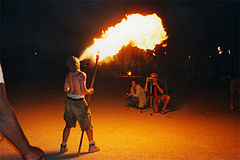 Fire breathers risk burns, both internal and external, as well as poisoning in the pursuit of their art.
Fire breathers risk burns, both internal and external, as well as poisoning in the pursuit of their art.
A traditional circus performance is often led by a ringmaster who has a role similar to a Master of Ceremonies. The ringmaster presents performers, speaks to the audience, and generally keeps the show moving. The activity of the circus traditionally takes place within a ring; large circuses may have multiple rings, like the six-ringed Moscow State Circus. A circus often travels with its own band, whose instrumentation in the United States has traditionally included brass instruments, drums, glockenspiel, and sometimes the distinctive sound of the calliope.
Acts
Common acts include a variety of acrobatics, gymnastics (including tumbling and trampoline), aerial acts (such as trapeze, aerial silk, corde lisse), contortion, stilts and a variety of other routines. Juggling is one of the most common acts in a circus; the combination of juggling and gymnastics is called equilibristics and include acts like plate spinning or the rolling globe. Clowns are common to most circuses and are typically skilled in many circus acts; "clowns getting into the act" is a very familiar theme in any circus. Famous circus clowns have included Austin Miles, the Fratellini Family, Emmett Kelly, Grock and Bill Irwin.
Daredevil stunt acts and sideshow acts are also parts of some circus acts, these activities may include human cannonball, chapeaugraphy, fire eating, breathing and dancing, knife throwing, magic shows, sword swallowing or strongman. Famous sideshow performers include Zip the Pinhead and The Doll Family. A popular sideshow attraction from the early 19th century was the flea circus, where fleas were attached to props and viewed through a Fresnel lens.
Animal acts
 Female lion tamer and leopard. Animal rights activists allege that these acts involve cruel training methods.
Female lion tamer and leopard. Animal rights activists allege that these acts involve cruel training methods.
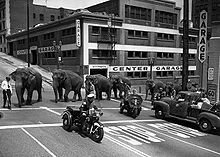 Elephants from Cole Brothers Circus parade through downtown Los Angeles, 1953
Elephants from Cole Brothers Circus parade through downtown Los Angeles, 1953
A variety of animals have historically been used in acts. While the types of animals used vary from circus to circus, big cats, elephants, horses, birds, sea lions, bears and domestic animals are the most common.
The earliest involvement of animals in circus was just the display of exotic creatures. As far back as the early eighteenth century, exotic animals were transported to North America for display, and menageries were a popular form of entertainment.[27] The first true animals acts in the circus were equestrian acts. Soon elephants and big cats were displayed as well. Isaac A. Van Amburgh entered a cage with several big cats in 1833, and is generally considered to be the first wild animal trainer in American circus history.[28] Mabel Stark was a famous female tiger-tamer.
Controversy
Animal welfare groups have documented many cases of animal cruelty in the training of performing circus animals.[29][30] The animal rights group People for the Ethical Treatment of Animals (PETA) contends that animals in circuses are frequently beaten into submission and that physical abuse has always been the method for training circus animals. According to PETA, although the US Animal Welfare Act does not permit the use of electric shock prods, whips, hooks, or similar instruments by trainers,[31] these are still used today.[32] According to PETA, during an undercover investigation of Carson & Barnes Circus, video footage was captured showing animal care director Tim Frisco training endangered Asian elephants with electrical shock prods and instructing other trainers to "beat the elephants with a bullhook as hard as they could and to sink the sharp metal bullhook into the animals' flesh and twist it until they screamed in pain."[32]
In testimony in U.S. District Court in 2009, Ringling Bros. and Barnum & Bailey Circus CEO Kenneth Feld acknowledged that circus elephants are struck behind the ears, under the chin and on their legs with metal tipped prods, called bull hooks. Feld stated that these practices are necessary to protect circus workers. Feld also acknowledged that an elephant trainer was reprimanded for using an electric shock device, known as a hot shot or electric prod, on an elephant, which Feld also stated was appropriate practice. Feld denied that any of these practices harm elephants.[33] In its January 2010 verdict on the case, brought against Feld Entertainment International by the American Society for the Prevention of Cruelty to Animals 'et al.', the Court ruled that evidence against the circus company was "not credible with regard to the allegations".[34]
On February 1, 1992 at the Great American Circus in Palm Bay, Florida, an elephant named Janet (1965 – February 1, 1992) went berserk while giving a ride to a mother, her two children and three other children. The elephant then stampeded through the circus grounds outside before being shot to death by police.[35] Also, during a Circus International performance in Honolulu, Hawaii on 20 August 1994, an elephant called Tyke (1974 – August 20, 1994) killed her trainer, Allen Campbell, and severely mauled her groomer, Dallas Beckwith, in front of hundreds of horrified spectators. Tyke then bolted from the arena and ran through the streets of Kakaako for more than thirty minutes. Police fired 86 shots at Tyke who eventually collapsed from the wounds and died.[36]
In 1998 in the UK, a parliamentary working group chaired by MP Roger Gale studied living conditions and treatment of animals in UK circuses. All members of this group agreed that a change in the law was needed to protect circus animals. Mr Gale told the BBC, "It's undignified and the conditions under which they are kept are woefully inadequate—the cages are too small, the environments they live in are not suitable and many of us believe the time has come for that practice to end." The group reported concerns about boredom and stress, and noted that an independent study by a member of the Wildlife Conservation Research Unit at Oxford University "found no evidence that circuses contribute to education or conservation."[37] However, in 2007 a different working group under the UK Department for Environment, Food and Rural Affairs, having reviewed information from experts representing both the circus industry and animal welfare, found an absence of "scientific evidence sufficient to demonstrate that travelling circuses are not compatible with meeting the welfare needs of any type of non-domesticated animal presently being used in the United Kingdom." According to that group's report, published in October 2007, "there appears to be little evidence to demonstrate that the welfare of animals kept in travelling circuses is any better or any worse than that of animals kept in other captive environments."[38]
Sweden, Austria, Costa Rica, India, Finland, Singapore, Switzerland, and Denmark have already restricted the use of animals in entertainment. In response to a growing popular concern about the use of animals in entertainment, animal-free circuses are becoming more common around the world.[39] Israel has banned any animal from performing in any circus.[citation needed] In 2009, Bolivia passed legislation banning the use of any animals, wild or domestic, in circuses. The law states that circuses "constitute an act of cruelty." Circus operators had one year from the bill's passage on July 1, 2009 to comply.[40]
In music, films, plays, and books
See also: Circus musicThe atmosphere of the circus has served as a dramatic setting for many musicians. The famous circus theme song is actually called "Entrance of the Gladiators", and was composed in 1904 by Julius Fučík. Other circus music includes "El Caballero", "Quality Plus", "Sunnyland Waltzes", "The Storming of El Caney", "Pahjamah", "Bull Trombone", "Big Time Boogie", "Royal Bridesmaid March", "The Baby Elephant Walk", "Liberty Bell March", "Java", Strauss's "Radetsky March", and "Pageant of Progress". A poster for Pablo Fanque's Circus Royal, one of the most popular circuses of Victorian England, inspired John Lennon to write Being for the Benefit of Mr. Kite! on The Beatles' album, Sgt. Pepper's Lonely Hearts Club Band. The song title refers to William Kite, a well-known circus performer in the 19th century. Producer George Martin and EMI engineers created the song’s fairground atmosphere, one that epitomizes the feel of the entire album, by assembling a sound collage of collected recordings of calliopes and fairground organs, which they cut into strips of various lengths, threw into a box, and then mixed up and edited together randomly, creating a long loop which was mixed into the final production.[41]
In 2008, Britney Spears released an album entitled Circus. It sold 505,000 copies within the U.S and 814,000 copies worldwide within the first week of its release. The album debuted at number 1 on the Billboard 200 chart. The feat also earned Spears a place in the Guinness Book of World Records due to Spears becoming the youngest female artist in history to have five number one albums. The album spawned hits like Womanizer and Circus. Circus sold close to 5 million copies worldwide.
Plays set in a circus include the 1896 musical The Circus Girl by Lionel Monckton, Polly of the Circus written in 1907 by Margaret Mayo, He Who Gets Slapped written by Russian Leonid Andreyev 1916 and later adapted into one of the first circus films, Caravan written in 1932 by Carl Zuckmayer, the revue Big Top written by Herbert Farjeon in 1942, Top of the Ladder written by Tyrone Gutheris in 1950, Stop the World, I Want to Get Off written by Anthony Newley in 1961, and Barnum with music by Cy Coleman and lyrics and book by Mark Bramble.
Following World War I, circus films became popular; in 1924 He Who Gets Slapped was the first film released by MGM; in 1925 Sally of the Sawdust (remade 1930), Variety, and Vaudeville were produced, followed by The Devil's Circus in 1926 and The Circus starring Charlie Chaplin, Circus Rookies, 4 Devils; and Laugh Clown Laugh in 1928. German film Salto Mortale about trapeze artists was released in 1930 and remade in the United States and released as Trapeze starring Burt Lancaster in 1956; in 1932 Freaks was released; Charlie Chan at the Circus, Circus (USSR) and The Three Maxiums were released in 1936 and At the Circus starring the Marx Brothers and You Can't Cheat an Honest Man in 1939. Circus films continued to be popular during the Second World War, The Great Profile starring John Barrymore was released in 1940, the animated Disney film Dumbo, Road Show and The Wagons Roll at Night in 1941 and Captive Wild Woman in 1943.
The film Tromba, about a tiger trainer was released in 1948 and in 1952 Cecil B. de Mille's Oscar winning film The Greatest Show on Earth was first shown. Released in 1953 were Man on a Tightrope and Ingmar Bergman's Gycklarnas afton released as Sawdust and Tinsel in the United States; Life is a Circus; Ring of Fear; 3 Ring Circus and La strada an Oscar winning film by Federico Fellini about a girl who is sold to a circus strongman; Fellini made a second film set in the circus called The Clowns in 1970. Films about the circus made since 1959 include B-movie Circus of Horrors, musical Billy Rose's Jumbo, A Tiger Walks a Disney film about a tiger that escapes from the circus and Circus World starring John Wayne. In the film Jungle Emperor Leo, Leo's son, Lune, is captured and placed in a circus, which burns down when a tiger knocks down a ring of fire while jumping through it.
The TV series Circus Humberto, based on the novel by Eduard Bass, follows the history of the circus family Humberto between 1826 and 1924. The setting of the HBO television series Carnivàle, which ran from 2003 to 2005, is also largely set in a traveling circus. The circus has also inspired many writers. Numerous books, both non-fiction and fiction, have been published about circus life. Notable examples of circus-based fiction include Circus Humberto by Eduard Bass, Cirque Du Freak by Darren Shan, and Spangle by Gary Jennings. The novel "Water for Elephants" by Sara Gruen tells the fictional tale of a circus veterinarian and was made into a movie with the same title starring Robert Pattinson and Reese Witherspoon.
Buildings
In some towns, there are circus buildings where regular performances are held. The best known are
- Circus Krone Building in Munich
- Moscow Circus on Tsvetnoy Boulevard in Moscow
- Shanghai Circus World in Shanghai
- Cirque d'Hiver, Paris
- Budapest Circus
- Blackpool Tower Circus
- Hippodrome Circus, Great Yarmouth
In other countries, purpose-built circus buildings still exist which are no longer used as circuses, or are used for circus only occasionally among a wider programme of events; for example, the Cirkusbygningen (The Circus Building) in Copenhagen, Denmark or Cirkus in Stockholm, Sweden.
See also
 The Circus, by Georges Seurat, painted 1891. Original in Musée d'Orsay, Paris.
The Circus, by Georges Seurat, painted 1891. Original in Musée d'Orsay, Paris.
- Acrobatics
- Aerobatics
- Animal training
- Chautauqua, tent shows that preceded American circus
- Circus clown
- Circus skills
- Cirque du Soleil
- Clown
- Contemporary circus
- Dog and pony show
- List of circuses and circus owners
Notes
- ^ circus, Charlton T. Lewis, Charles Short, A Latin Dictionary, on Perseus
- ^ krikos, Henry George Liddell, Robert Scott, A Greek-English Lexicon, on Perseus
- ^ History of the Ludi NovaRoma.org
- ^ The Oxford English Dictionary lists the 1791 book The History of the Royal Circus about Philip Astley's troupe as the first written use of the word to describe the modern circus.
- ^ Schechter, Joel (2001) The pickle clowns: new American circus comedy p.11. Southern Illinois University Press
- ^ a b Explore PA history.com – Historical Markers
- ^ 'Popular Entertainments through the Ages', Samuel McKechnie. London; Sampson Low, Marston & Co Ltd., 1931
- ^ The Circus in America: 1793 – 1940
- ^ PHMC: Historical Markers Program
- ^ The Circus in America: 1793 – 1940
- ^ The Circus in America: 1793 – 1940
- ^ J. Griffin. "Frost, Thomas (1881), "Circus Life and Circus Celebrities." London: Chatto and Windus". Circushistory.org. http://www.circushistory.org/Frost/Frost5.htm. Retrieved 2011-04-09.
- ^ Leeds Intelligencer, 4th March 1854, p 5 col 3.
- ^ Victoria and Albert Museum. ""Victorian Circus"". V&A. http://www.vam.ac.uk/content/articles/v/victorian-circus/. Retrieved 2011-06-19.
- ^ International Circus Festival of Monte-Carlo
- ^ Vazquez Hermanos Circus by Hank Duckman
- ^ The 7 Fingers
- ^ Circus Baobab
- ^ Dislocate
- ^ http://www.vulcana.org.au/
- ^ Company PURE Cirkus
- ^ Skewed Circus
- ^ Collins, Glenn (April 28, 2009). "Run Away to the Circus? No need. It's Staying Here". The New York Times. http://www.nytimes.com/2009/04/29/theater/29circ.html?_r=3&pagewanted=2&hp. Retrieved 2009-09-30.
- ^ "About Cirque du Soleil". Cirque du Soleil. http://www.cirquedusoleil.com/en/about/intro/intro.asp. Retrieved 2009-09-30.
- ^ Hermanos Mayar Circus by Hank Duckman
- ^ Moira Orfei Circo official website
- ^ The history of circus in the US, HistoryMagazine
- ^ The Circus in America: 1793 – 1940
- ^ "Circus Incidents: Attacks, Abuse and Property Damage" (PDF). Humane Society of the United States. 2004-06-01. http://www.hsus.org/web-files/PDF/2004_HSUS_Circus_Incidents.pdf. Retrieved 2008-05-23.
- ^ http://www.peta.org/issues/animals-in-entertainment/circuses.aspx
- ^ Animal Welfare Act and Animal Welfare Regulations
- ^ a b Circuses: Three Rings of Abuse
- ^ Circus CEO says elephants are struck, but not hurt
- ^ Court Record, United States District Court for the District of Columbia, Civil Action No 03-2006 (EGS)
- ^ St. Petersburg Times (May 6, 1993). "Elephant incidents in recent years". http://news.google.com/newspapers?nid=888&dat=19930506&id=jfgNAAAAIBAJ&sjid=X3sDAAAAIBAJ&pg=6834,42417. Retrieved 19 April 2010.
- ^ "Hawthorn Corporation". Circuses.com. http://www.circuses.com/fact-hawthorn.asp.
- ^ UK Politics Protect circus animals call
- ^ "Wild Animals in Travelling Circuses: The Report of the Chairman of the Circus Working Group". UK Department for Environment, Food and Rural Affairs. October 2007. Retrieved 24 February 2010.
- ^ Elephant Rampages
- ^ Associated Press (July 31, 2009). "Bolivia bans use of animals in circuses". http://www.chron.com/disp/story.mpl/ap/latinamerica/6555306.html. Retrieved 31 July 2009.[dead link]
- ^ Turner, Steve, "A Hard Day's Write." HarperCollins(1984).
References
- Croft-Cooke, Rupert and Cotes, Peter. 1976. Circus: A World History. Elek. London ISBN 0-236-40051-7
- Johnson, William M. 1990. The Rose-Tinted Menagerie. Iridescent Publishing
- National Museum of Performing Arts, Theatre Museum. Circus Guided Tour
 This article incorporates text from a publication now in the public domain: Chisholm, Hugh, ed (1911). Encyclopædia Britannica (11th ed.). Cambridge University Press.
This article incorporates text from a publication now in the public domain: Chisholm, Hugh, ed (1911). Encyclopædia Britannica (11th ed.). Cambridge University Press.Further reading
- Dfening, Fred D., III (November 2007). "The American Circus in the 1870s: An Overview from Newspaper Sources". Bandwagon (Columbus, OH: Circus Historical Society) 51 (6): 4–60. ISSN 0005-4968.—provides an overview of "low-yield research" into the history of the American Circus as covered in "ragcontent newspapers [and] magazines [such as] White Tops".
- Brooke, Bob (October/November 2001). "Step Right Up: Bob Brooke presents the history of the circus in America". History Magazine. http://www.history-magazine.com/circuses.html.
External links
Categories:- Circuses
- Performing arts
- Greek loanwords
Wikimedia Foundation. 2010.

